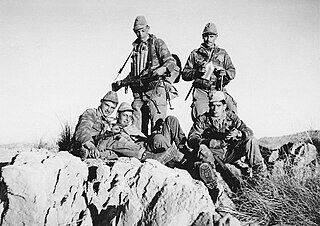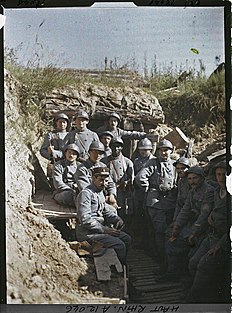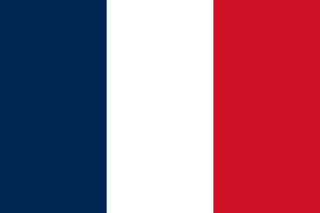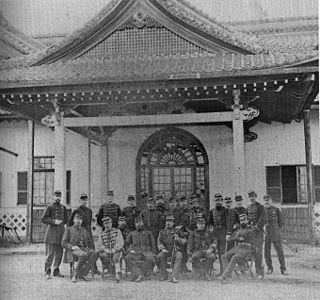 W
WThe French Army, officially the Ground Army to distinguish it from the French Air Force, armée de l'Air or Air Army, is the land-based and largest component of the French Armed Forces. It is responsible to the Government of France, along with the other four components of the Armed Forces. The current Chief of Staff of the French Army (CEMAT) is General Thierry Burkhard, a direct subordinate of the Chief of the Defence Staff (CEMA). General Burkhard is also responsible, in part, to the Ministry of the Armed Forces for organization, preparation, use of forces, as well as planning and programming, equipment and Army future acquisitions. For active service, Army units are placed under the authority of the Chief of the Defence Staff (CEMA), who is responsible to the President of France for planning for, and use, of forces.
 W
WIn France, the bleuet de France is the symbol of memory for, and solidarity with, veterans, victims of war, widows, and orphans, similar to the British Commonwealth remembrance poppy. The sale of "bleuet de France" badges on 11 November and 8 May is used to finance charitable works for those causes.
 W
WChasseur, a French term for "hunter", is the designation given to certain regiments of French and Belgian light infantry or light cavalry to denote troops trained for rapid action.
 W
WThe Chief of the Army Staff is the military head of the French Army. The chief directs the army staff and acts as the principal advisor to the Chief of the Defence Staff on subjects concerning the Army. As such, they ensure the operational preparedness of their service branch, express their need for military and civilian personnel, and are responsible for maintaining the discipline, morale and conduct of their troops.Special responsibilities can be assigned to them in relation to nuclear safety.
 W
WThe Choir of the French Army (commonly known as the Armed Forces Choir is an official academic ensemble of the Republican Guard of France. Its current director is Major Aurore Tillac. This male-voice choir is composed of 46 professional singers.
 W
WThe Commandos de Chasse were a French Counterinsurgency Commando force raised for the Algerian war.
 W
WFÉLIN is the name for the French infantry combat system developed by Safran Electronics & Defense.
 W
WThe French Revolutionary Army was the French force that fought the French Revolutionary Wars from 1792 to 1802. These armies were characterised by their revolutionary fervour, their poor equipment and their great numbers. Although they experienced early disastrous defeats, the revolutionary armies successfully expelled foreign forces from French soil and then overran many neighboring countries, establishing client republics. Leading generals included Jourdan, Bonaparte, Masséna and Moreau.
 W
WThe Armenian Legion was a foreign unit within the French Army active during and just after World War I which fought against the Ottoman Empire. The original name of the legion was "La Légion d'Orient". It was renamed "La Légion Arménienne" on February 1, 1919. The soldiers in this legion were referred to informally among Armenians as Gamavor (Volunteer).
 W
WThis article is about the French Army in World War I. During World War I, France was one of the Triple Entente powers allied against the Central Powers. Although fighting occurred worldwide, the bulk of the fighting in Europe occurred in Belgium, Luxembourg, France and Alsace-Lorraine along what came to be known as the Western Front, which consisted mainly of trench warfare. Specific operational, tactical, and strategic decisions by the high command on both sides of the conflict led to shifts in organizational capacity, as the French Army tried to respond to day-to-day fighting and long-term strategic and operational agendas. In particular, many problems caused the French high command to re-evaluate standard procedures, revise its command structures, re-equip the army, and to develop different tactical approaches.
 W
WRank insignia in the French Army are worn on the sleeve or on shoulder marks of uniforms, and range up to the highest rank of Marshal of France, a state honour denoted with a seven-star insignia that was last conferred posthumously on Marie Pierre Koenig in 1984.
 W
WThe 1911–1914 French military mission to Greece was called to Greece by the government of Eleftherios Venizelos to reorganize the Hellenic Army, parallel to a British naval mission for the Royal Hellenic Navy. The French mission arrived in January 1911, under the command of General Joseph-Paul Eydoux, replaced in April 1914 by General Étienne de Villaret. Its reforms contributed to the Greek army's success during the Balkan Wars of 1912–1913. It remained in the country until it was repatriated shortly after the outbreak of World War I in August 1914.
 W
WThe French Military Mission to Japan of 1867-68 was one of the first foreign military training missions to Japan. The mission was formed by Napoléon III, following a request of the Japanese Shogunate in the person of its emissary to Europe, Shibata Takenaka (1823–1877).
 W
WThe 1872–1880 French military mission to Japan was the second French military mission to that country. It followed the first French military mission to Japan (1867–68), which had ended with the Boshin War and the establishment of the rule of Emperor Meiji.
 W
WThe 1884 French Military Mission to Japan was the third French military mission to that country and consisted of five men.
 W
WThe Garde mobile was intended to be the body which would in effect conscript all who had been able to avoid military service. The Garde would also take in all conscripts on completion of their army service. Napoleon III took up the idea and announced on 12 December 1866 that the Garde Mobile would eventually attain a strength of 400,000 troops. Its members were colloquially known as "Moblots". It origins lay in the crises that led up to the Franco-Prussian War, when Adolphe Niel, Minister of War for France under Emperor Napoleon III, attempted to bolster French military power creating a service which would provide reserves to be added to the regular French army. Although there was conscription into the army, not only was it not universal but middle-class people could purchase exemptions for their sons in a system known as Remplacement.
 W
WThe French Foreign Legion has had a long and unique history amongst the units of the French Army. The French Foreign Legion was historically formed of expatriate enlisted personnel led by French officers. Founded by a royal ordinance issued by King Louis Philippe of France on March 9, 1831 with aim of bolstering the strength of the French Army while also finding a use for the influx of refugees inundating France at the time. The Foreign Legion subsequently found a permanent home in the ranks of the French military. The Foreign Legion's history spans across Conquest of Algeria, the Franco-Prussian War, numerous colonial exploits, both World Wars, the First Indochina War, and the Algerian War.
 W
WModern equipment of the French Army is a list of equipment currently in service with the French Army. Figures are provided by the French Ministry of Defense for 2018.
 W
WUSS Rochambeau (AP-63) was a transport ship that saw service in the United States Navy during World War II. She was the only U.S. Naval vessel to be named for the French nobleman, Jean-Baptiste Donatien de Vimeur, comte de Rochambeau (1725–1807), who commanded the French troops in Washington's army during the American Revolutionary War.
 W
WMilitary interpreters in the French Army translate into and out of foreign languages for the French military. A sous-officier or interpreter officer serves in uniform, accompanying the French armed forces on all its foreign expeditions for 200 years. Today known as Officiers et Sous-officiers de Réserve Qualifiés Langues Etrangères (OSRQLE), they were formerly known as Officiers Linguistes de Réserve de l'Armée de Terre (OLRAT), Interprètes/Officiers Interprètes de Réserve de l'Armée de Terre (IRAT/OIRAT) or Officiers de Liaison et Interprète de Réserve (OLIR). The unit was first set up for Bonaparte's Egyptian expedition, and so their insignia is a sphinx on a blue terrestrial globe divided up by lingual barriers, on a round grey circular background with rays symbolising each of the languages spoken by their unit
 W
WThe Musique des Troupes de Marine (M-TDM) is a military band in the French Army, attached to the army's naval infantry branch; the Troupes de marine. It contributes to the prestige of many official ceremonies and gives honor to high ranking French personalities. It frequently represents the French Republic abroad in military tattoos and military parades in countries such as the United States, Canada, South Korea, Israel, India, Bulgaria, and Russia. Since 1991, the band has been located at the Camp de Satory in Versailles, Yvelines. Operationally, it is assigned to the Army Music Command.
 W
WPoilu is an informal term for a French World War I infantryman, meaning, literally, hairy one. It is still widely used as a term of endearment for the French infantry of World War I. The word carries the sense of the infantryman's typically rustic, agricultural background. Beards and bushy moustaches were often worn. The poilu was particularly known for his love of pinard, his ration of cheap wine.
 W
WThe Occupation of the Ruhr was a period of military occupation of the Ruhr region of Germany by France and Belgium between 11 January 1923 and 25 August 1925.
 W
WSocial background of officers and other ranks in the French Army, 1750–1815 discusses career paths and social stratification in the French Army from the mid-eighteenth century to the end of the Napoleonic wars. The Royal army during the Ancien regime was recruited through volunteer enlistment. Almost 90% of the recruits came from the peasantry and the working class, while about 10% came from the petty bourgeoisie. Privates were usually promoted directly to the rank of sergeant, bypassing the rank of corporal. At the time of the French revolution, a third of the sergeants came from the petty bourgeoisie or higher classes. Three career paths existed for officers; one privileged for the high nobility, one standard for the middle and lower nobility and the higher bourgeoisie, and one exceptional for promoted sergeants. The high nobility quickly reached high rank, the mean age of promotion to colonel was 36 years. The standard career path was based on seniority and was rather inert; the mean age of promotion to captain was 45 years. Promoted sergeants could normally not reach higher than to substantive lieutenants and captains by brevet, although their social background significantly deviated from the rank and file; over two-thirds came from the petty bourgeoisie or higher classes. The different career paths created a lack of social homogeneity in the officer corps. The military reforms after the Seven Years' War attempted to create a professionalized officer corps built on the petty nobility. But since the privileged career of the high nobility was retained, the attempt failed. In consequence, many noblemen in the officer corps sided with the bourgeoisie in the struggle against the class prerogatives of the high nobility. The French revolution changed everything. Conscription replaced volunteer enlistment. Regulations favoring sergeants as well as the flight of the nobility created an officer corps who under Napoleon contained a large majority of former sergeants. The Grand Armée was an army officered by the bourgeoisie; over half of the officers came from the higher bourgeoisie, a third from the petty bourgeoisie, and a sixth from the peasantry. The number of officers from the old nobility was higher than the number from the working class. Three-fourths were former sergeants, while one-fourth was appointed directly from civilian life.
 W
WThe Voltigeurs were French military skirmish units created in 1804 by Emperor Napoleon I. They replaced the second company of fusiliers in each existing infantry battalion.
 W
W W
W W
W W
W